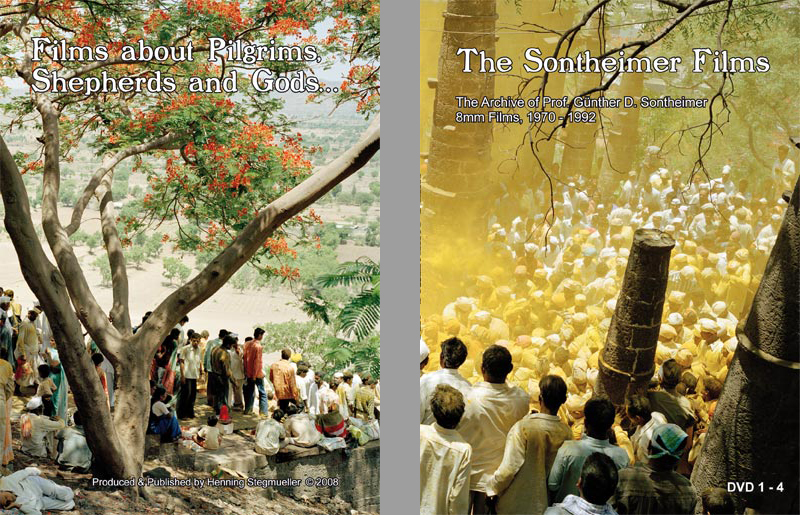
vimeo/henningstegmueller
Produced and published by Henning Stegmueller
A German Pioneer in the Study of Indian Culture:
Guenther Dietz Sontheimer (1934-1992) was an extraordinary scholar of Hinduism, Indian society and culture. Educated in Tuebingen, London, and Pune his first focus of study was Hindu law and its historical evolution. However, while studying Hindu law in Pune, Guenther Sontheimer met D.D. Kosambi - an interdisciplinary scholar and researcher - who had invented a method of investigating history on the basis of its living remnants in different social traditions. These new insights inspired Sontheimer to turn from desk research to field investigations and he started by studying the folk deities of the Dhangar shepherds in Maharashtra.
Until then this was uncharted territory for most Indologists and Sontheimer’s new preoccupation was viewed with scepticism by most of his colleagues who were unwilling to accept tribal lore and folk traditions as proper or relevant sources for the study of Hinduism. They scoffed at the idea of a religion without scriptures and texts, codified laws, and prescribed rites and rituals.
Once Sontheimer started his investigations into the traditions of the mostly illiterate nomadic pastoral tribes of Maharashtra, he realized that to establish the reality of his findings he had to document it. At that time, audio tape recording and cinema film recording were the only available means, and he used them again and again to describe folk festivals, rituals, songs and dances, and other performances that created the kind of evidence fellow-scholars would accept in research papers, books, seminars, symposia, and conferences.
In the three decades Sontheimer was engaged in his research of folk religion, he filmed from 1970-1992 a total of 30 hours of film footage in 8mm format. This archival material was restored and transferred by Henning Stegmueller, who worked with Sontheimer on his last two documentary features.
Films about Pilgrims, Shepherds and Gods...
This package of documentary films made by Guenther D. Sontheimer and inspired by him and his research in folk and tribal traditions of Maharashtra is now available for the use of educational and research institutions as well as individual scholars and teachers.
- King Khandoba: Scenes from the Life of an Indian Folk God
A film by Guenther Sontheimer and Guenter Unbescheid (30 min, color, 1978).
The film is based on the folklore and folk festivals of Khandoba, the oldest living cult deity of Maharashtra considered the ‘King’ of Jejuri by his millions of devotees.
- The Journey of the Hatkar Dhangars
A film by Henning Stegmueller and Marie-José van de Loo (45 min, color, 1986).
The film documents the seasonal journey of a pastoral nomadic shepherd tribe - the Hatkar Dhangars from the tablelands of Maharashtra, the Dekhan, to the coastal Konkan region. A unique feature of this film is its recording of the Dhangars’ traditional narrative songs about their origin and ancestors.
- Vari - An Indian Pilgrimage
A film by Guenther Sontheimer and Henning Stegmueller (88 min. color, 1989).
This film is an epic narrative documentary covering the most popular pilgrimage in Maharashtra to celebrate its deity Vitthal in Pandharpur. The pilgrimage starts from Alandi, the resting place of the 13th century poet-saint Dnyaneshwar, and from Dehu, the native place of the 17th poet-saint Tukaram. Symbolic ‘sandals’ of the two poet-saints are carried in palanquins from the two points of departure by thousands of pilgrims. The two palanquins have slightly different routes and people from all over Maharashtra join them. The pilgrims sing and dance on their way and have regular camping sites where local people receive them with love and respect. At regular intervals the film cuts to interviews with Maharashtrian scholars and writers who explain the significance of the pilgrimage.
- King Khandoba’s Hunting Expedition
A film by Guenther Sontheimer and Henning Stegmueller (82 min, color, 1992).
This film uses a kind of magic realism to transport the viewer from contemporary Jejuri, a small pilgrim town near Pune that has a fortress-like temple of the God-king Khandoba, through scenes of the Somavati Amavasya (New Moon Monday) festival that celebrates the marriage of Khandoba with the beautiful Dhangar shepherdess, Banu or Banai. It tells the story of Khandoba seeing Banu in a dream and getting smitten by her. Under the pretext of a hunt, he goes in search of Banu and woos her for several years in the guise of an old man. After twelve years, Khandoba rides back to Jejuri with Banu and his subjects cheer the couple and carry them to the King’s temple-palace.
- A Divine Play on Earth: Sontheimer’s Discovery of India
A film by Henning Stegmueller (82 min, color, 2008).
The film flashes back to Sontheimer’s life and work through interviews with his sister in Germany and his host family in India, his friends, and his colleagues. It also presents his visual documentation of the folk festival and folk life he owed his insightful research to. The film presents the many facets of the human being Sontheimer was and the brilliant scholar admired by his fraternity. Most importantly, it presents Sontheimer not as a mystery or an icon but as a man who completely merged with what he studied and came back to explain it to the world.
The Sontheimer Films
A comprehensive package of this rare archival material is now available for the use of educational and research institutions as well as individual scholars and teachers.
(Selected and edited by H. Stegmüller (2008) 6 hours, color).
Also available at:
Südasien-Institut
Voßstr.2
D-69115 Heidelberg
Telefon:+49 6221 54-0 15200
presse@sai.uni-heidelberg.de
